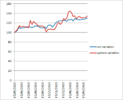- Joined
- 28 December 2013
- Posts
- 6,401
- Reactions
- 24,350
It's not easy
Profiting from the stock market is exceedingly difficult to do consistently over a long period of time because the market is irrational and emotional. It moves in a manner that has little appreciation for what we might think is reasonable.
Taking control
Trading is about taking control, it's about being active & not passive. Our aim is to identify opportunities by anticipating a move in a direction we can take advantage of. If we are right stay & catch a good trend - it pays to stay on the ride as long as we can till the momentum slows or changes direction - maximising profit. If you exit a position too early or use a "take profit stop" in your strategy - you'll forego the right to the rewards for the risk you have taken.
I'll leave the last word to @peter2
"It's all to easy to post when things are going well and stroke our own egos. When regular posters go quiet, we know they're having a bad run. I post when I'm frustrated and that helps me understand why. I post when my selections are "out of sync" with what's moving in the market because it helps me see what I need to correct. I post about the big losers because they're the trades that provide us with lessons to learn. They reinforce things I already know, but I hope others take note as well".
Skate.
Profiting from the stock market is exceedingly difficult to do consistently over a long period of time because the market is irrational and emotional. It moves in a manner that has little appreciation for what we might think is reasonable.
Taking control
Trading is about taking control, it's about being active & not passive. Our aim is to identify opportunities by anticipating a move in a direction we can take advantage of. If we are right stay & catch a good trend - it pays to stay on the ride as long as we can till the momentum slows or changes direction - maximising profit. If you exit a position too early or use a "take profit stop" in your strategy - you'll forego the right to the rewards for the risk you have taken.
I'll leave the last word to @peter2
"It's all to easy to post when things are going well and stroke our own egos. When regular posters go quiet, we know they're having a bad run. I post when I'm frustrated and that helps me understand why. I post when my selections are "out of sync" with what's moving in the market because it helps me see what I need to correct. I post about the big losers because they're the trades that provide us with lessons to learn. They reinforce things I already know, but I hope others take note as well".
Skate.











